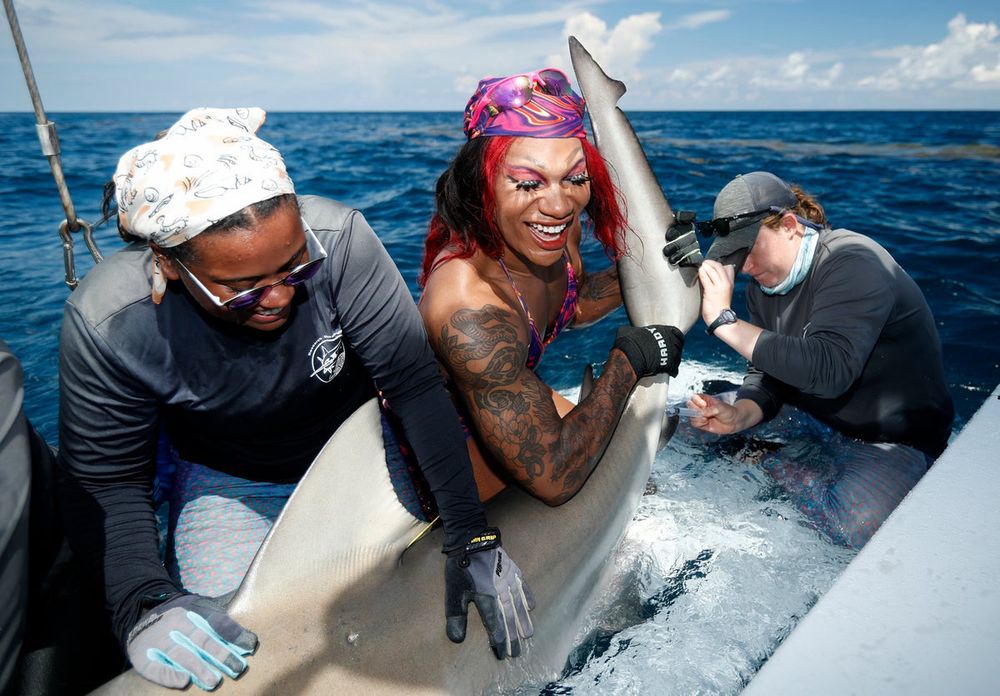
Schematic diagram of the influence of seabirds on temperate and tropical near-shore marine systems.
Temperatre systems:
- Nutrient enrichment and predation on herbivorous invertebrates can lead to increased algal production
- Phytoplankton communities change, featuring more large-celled species
- Intertidal organisms incorporate seabird-enriched material by grazing on detritus and biofilm in tidepools
- Macroalgae biodiversity and primary production are boosted
Tropical systems:
- Mangrove leaf nutritional quality increases
- Corals recover faster after bleaching events
- Fish biomass increases across different trophic groups
- Pelagic and benthic consumers' foraging behaviour shifts
- Parrotfish grazing and bioerosion rates increase
- Fish grow larger
New in @natrevbiodiv.nature.com: our review of the influence of #seabirds, via their nutrient transfer, on islands & adjacent marine ecosystems 🐦🏝️🪸
We highlight knowledge gaps & future directions ✨
"The circular seabird economy is critical for oceans, islands and people": doi.org/10.1038/s443...
27.10.2025 07:49 — 👍 65 🔁 35 💬 3 📌 0
WOW!!! Congratulations to the authors on a timely and important perspective on how we move forward in coral reef conservation. A must read 🪸🐠
16.10.2025 02:29 — 👍 3 🔁 1 💬 1 📌 0

Schematic of two potential impact pathways (direct benthic impacts and midwater impacts) of deep-sea mining for polymetallic nodules, polymetallic sulphides, and cobalt-rich ferromanganese crusts.
"Deep-sea mining risks for sharks, rays, and chimaeras" www.cell.com/current-biol...
@seaprinceaaron.bsky.social & colleagues
@currentbiology.bsky.social
08.10.2025 16:00 — 👍 25 🔁 15 💬 2 📌 0
"Overfishing the largest species in nearshore and pelagic habitats risks loss of ecomorphotypes and a 5 to 22% erosion of functional diversity."
Ecological erosion and expanding extinction risk of sharks and rays
Dulvy @nickdulvy.bsky.social et al 2024
03.08.2025 13:54 — 👍 19 🔁 12 💬 0 📌 0

Figure 1: highlighting various pathways through which mining can impact sharks, rays, and chimaeras including collector impact and plumes, and discharge plumes.

Figure 2: The diversity of sharks, rays, and chimaeras impacted by deep sea mining operations. Nearly 2/3 of these species are already at an elevated risk of extinction.
New paper led by @seaprinceaaron.bsky.social in @currentbiology.bsky.social looking at the threats deep sea mining poses for sharks, rays, and chimaeras. We found 30 species are threatened via various pathways including collector impact and plumes at depth and pelagic discharge plumes.
02.10.2025 21:40 — 👍 12 🔁 13 💬 1 📌 1
#deepseamining #polymetallicnodules #conservation #marineconservation #marinebiodiversity #mantaray #whaleshark #ghostshark #whiteshark #cookiecuttershark #chocolateskate #baskingshark #megamouthshark #sharkconservation #marinebiology #mining #ocean #deepsea #chimaera #marinelife #sharkscience
02.10.2025 19:54 — 👍 1 🔁 1 💬 0 📌 0
Great to team up with @cgmull.bsky.social @nickdulvy.bsky.social @britfinucci.bsky.social, Victoria and Jeff, to bring sharks, rays, and chimaeras to the larger discourse on deep-sea mining. This paper is also my first first-author publication and I am excited it could be this one!
02.10.2025 19:54 — 👍 5 🔁 2 💬 2 📌 0

a dolphin is jumping out of the water in the ocean
ALT: a dolphin is jumping out of the water in the ocean
What we need:
1. Updates to ISA, IUCN, and other assessments incorporating the risks of mining to chondrichthyans.
2. Enhanced sampling and monitoring.
3. Spatial management tools to protect at-risk species.
4. A deeper discharge plume, but must assess biodiversity impacts and further risks
02.10.2025 19:54 — 👍 2 🔁 0 💬 1 📌 0

This figure shows the percentage of species richness present over the depth range in comparison to the discharge plume and benthic impacts. Species richness in most areas reaches 0 at 2,000 m or so, however in polymetallic sulphide areas, as many as 4 species remain at-risk in deeper systems.
Figure 4 Vertical conservation benchmarks for discharge and mining depths based on the potential overlap of chondrichthyans with the mining footprint. Each line is a contractor (see Table S3), and dashed lines denote where 50% and 75% of assemblages no longer overlap by depth (i.e., 50% and 25% species richness remaining). An additional dashed line denotes 2,000 and 3,000 m and the number of species remaining at or below these depths. The dark gray areas refer to depths of direct benthic impacts, while light gray areas refer to discharge plume scenarios. Mining types are PMNs (polymetallic nodules), PMSs (polymetallic sulphides), and CFCs (cobalt-rich ferromanganese crusts).
Where should the discharge plume go? Some results:
1️⃣ Deeper than 2000 m where there is limited chondrichthyan overlap. But ecosystem impacts remain.
2️⃣ At the seafloor to limit pelagic disturbance BUT this will further threaten benthic biodiversity (inc. chondrichthyans, see sulphide mining - PMS)
02.10.2025 19:54 — 👍 1 🔁 0 💬 1 📌 0

This figure shows the depth ranges of species in relation to the discharge plume and benthic impacts from mining. Species vary in their overlap but 25 overlap vertically in depth and 17 of these species have > 50% depth overlap.
Figure 3 Potential depth range overlap of chondrichthyans with the deep-sea mining footprint.
Potential depth range overlap of chondrichthyans with (A) PMN, (B) PMS, and (C) CFC mining. Depth ranges are minimum and maximum depths of species, and overlap statistics are calculated based on the minimum and maximum depths of discharge plume scenarios and the mining type. The gradient in overlap for each species reflects a moving window where the discharge plume is moved 1 meter down with each scenario, and the overlap is subsequently recalculated at the meter scale. The dark gray areas refer to direct benthic impacts, while light gray areas refer to discharge plume scenarios. Numbers reflect species that have 50% or higher depth overlap for benthic impacts specifically.
Potential depth overlap:
🌊 25 species overlap directly with seabed impacts, 17 have > 50% of their depth range overlapping
🌊 All species overlap with discharge plume scenarios
🌊 The chocolate skate has a 75% depth overlap and is egg-laying and benthic (traits which elevate its vulnerability)
02.10.2025 19:54 — 👍 0 🔁 0 💬 1 📌 0

Figure 2 Phylogenetic tree and heatmap displaying the chondrichthyans (n = 30) that intersect with deep-sea mining areas.
The heatmap shows the mining types within which each species occurs (PMNs, polymetallic nodules; PMSs, polymetallic sulfides; CFCs, cobalt-rich ferromanganese crusts), whether they occur in the Areas of Particular Environmental Interests (APEIs) (located in the Clarion-Clipperton zone), whether they are Convention on the Conservation of Migratory Species of Wild Animals (CMS) listed, their functional group, and their International Union for Conservation of Nature (IUCN) Red List status. An alternative color palette and extended trait data are available (Figure S1; Table S1).
30 species overlap:
🦈 Unique deep-sea species such as two chimaeras, the megamouth shark, great lanternshark, and cookiecutter shark
🦈 Deep divers such as devil and manta rays, the whale shark, and white shark
🦈 > 60% already threatened with extinction, 12-16 at-risk species per contractor
02.10.2025 19:54 — 👍 0 🔁 0 💬 1 📌 0
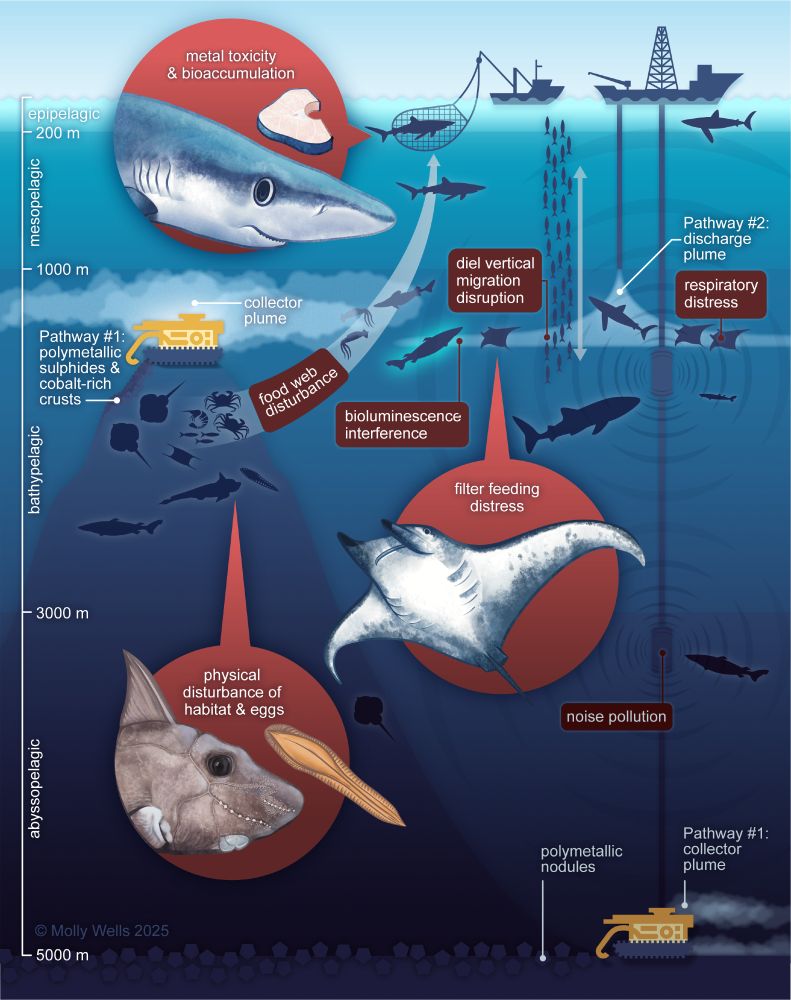
This figure illustrates two pathways for which deep-sea mining could impact sharks, rays, and chimaeras. The first pathway describes impact on the seabed, specifically through the collector vehicle and the plume generated from the vehicle. This pathway is especially of concern for benthic, benthopelagic, and egg-laying species and poses a threat to foraging areas and nurseries. The second pathway focuses on the midwater discharge plume. This plume will likely disrupt vertical migration and behaviour, filter feeding, and bioluminescence. Also, the plume may cause respiratory distress, reuslt in the accumulation of toxic metals in upper trophic levels, and further affect trophic functioning.
Figure 1 Schematic of two potential impact pathways (direct benthic impacts and midwater impacts) of deep-sea mining for polymetallic nodules, polymetallic sulphides, and cobalt-rich ferromanganese crusts. The discharge plume is depicted at a depth of 1,000 m for illustrative purposes. Illustration by Molly Wells (https://www.mollywells.ca/).
Mining poses risks via 2 pathways. 1) seabed impacts from the collector vehicle, especially to #nurseries and foraging areas. 2) impacts via the midwater #dischargeplume which could disrupt vertical migration, filter feeding, bioluminescence, and cause toxic metal accumulation.
🖼️Molly Wells
02.10.2025 19:54 — 👍 0 🔁 0 💬 1 📌 0
Mining in ABNJ could begin within the next few years, however #chondrichthyans have been left out of recommendations for environmental baselines, which are required by the #InternationalSeabedAuthority. This novel industry poses considerable risks to #biodiversity and #ecosystemfunctions
02.10.2025 19:54 — 👍 0 🔁 0 💬 1 📌 0

A world map showing the distribution of mineral resources considered for deep-sea mining.
Deep-sea mining will target three primary mineral types: polymetallic nodules (abyssal seafloor), polymetallic sulphides (vents), and cobalt-rich crusts (seamounts). The goal is to extract rare earth metals for the green transition (eg. for batteries)
🖼️ Miller et al. 2018
02.10.2025 19:54 — 👍 0 🔁 0 💬 1 📌 0

The Pygmy Shark (Euprotomicrus bispinatus), the world’s second smallest shark species and one of the species with a high overlap with proposed deep sea mining. Credit: Blue Planet Archive / Masa Ushioda.
🚨 NEW PUBLICATION 🚨
Today in @currentbiology.bsky.social, we found that 30 species of #sharks, #rays, and #chimaeras overlap with proposed #deepseamining in Areas Beyond National Jurisdiction #ABNJ - over 60% are already #threatened with #extinction 🦈
📸 Blue Planet Archive / Masa Ushioda
02.10.2025 19:54 — 👍 21 🔁 12 💬 2 📌 0
🧪🌏🦑🌊🦈 New paper alert #deepseamining #sharks
02.10.2025 17:00 — 👍 10 🔁 6 💬 0 📌 0
And for more on #shark #conservation, check out this well-aged review from @sharkcolin.bsky.social and colleagues
www.cell.com/current-biol...
02.10.2025 17:29 — 👍 11 🔁 4 💬 0 📌 0
Thank you so much Colin!!!
02.10.2025 18:56 — 👍 1 🔁 0 💬 0 📌 0

Deep-sea mining risks for sharks, rays, and chimeras
Judah et al. identify 30 species of chondrichthyans that overlap with proposed deep-sea
mining activities, nearly two-thirds of which are already threatened with extinction.
Precautionary management o...
New #sharkscience out in @currentbiology.bsky.social by @seaprinceaaron.bsky.social and colleagues.
Deep-sea mining risks for sharks, rays, and chimeras. A must read for this looming threat to many already threatened species.
www.cell.com/current-biol...
@iucnshark.bsky.social
02.10.2025 16:53 — 👍 18 🔁 8 💬 1 📌 3

Shark National Geographic GIF
ALT: Shark National Geographic GIF
First first-author paper just got accepted!!!! New deep-sea shark, ray, and chimaera science inbound 👻🦈
04.09.2025 21:24 — 👍 14 🔁 1 💬 0 📌 0

Outlasting the Heat: Collapse of Herbivorous Fish Control of Invasive Algae During Marine Heatwaves
🔗 buff.ly/YrXrJfn
@jeroenbrijs.bsky.social
31.08.2025 16:59 — 👍 2 🔁 2 💬 0 📌 0

🚨New PhD paper out today in @natcomms.nature.com with @renatoamorais.bsky.social and Dave Bellwood! 🚨
Marine fishes exhibit extraordinary patterns of diversity, but how does this diversity relate to their productivity? 🐟🐠🐡
🌐
🦑🧪
🔗 nature.com/articles/s41...
22.08.2025 03:27 — 👍 29 🔁 10 💬 3 📌 1
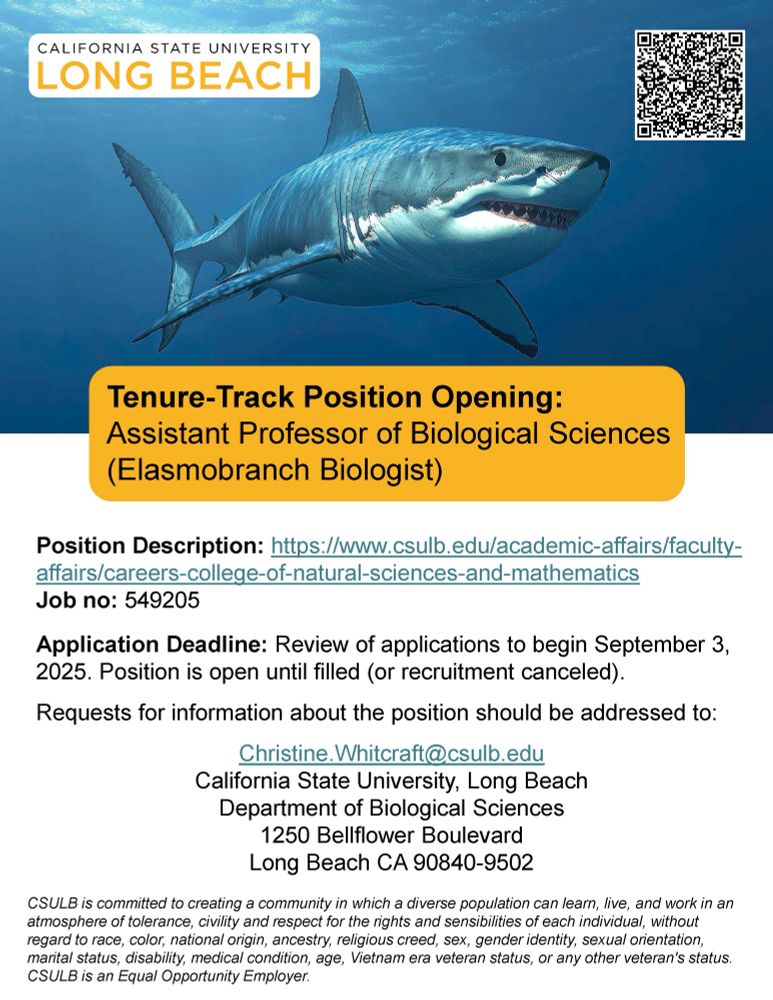
Flyer from CSU Long Beach advertising for the position of Assistant Professor of Elasmobranch Biology. The flyer has a picture of a white shark in the banner. Application deadline is September 03, 2025. Christine Whitcraft can be contacted for details at Christine.whitcraft@csulb.edu Full job description can be found here: https://careers.pageuppeople.com/873/lb/en-us/job/549205/assistant-professor-of-biological-sciences-elasmobranch-biologist
The Biology Department at CSU Long Beach is now advertising for an Assistant Professor of Elasmobranch Biology. Refer to the attached flyer for details. @uwsafs.bsky.social @uwmarinebiology.bsky.social @misselasmo.bsky.social @whysharksmatter.bsky.social @official-bweems.bsky.social
18.07.2025 18:52 — 👍 7 🔁 14 💬 0 📌 3
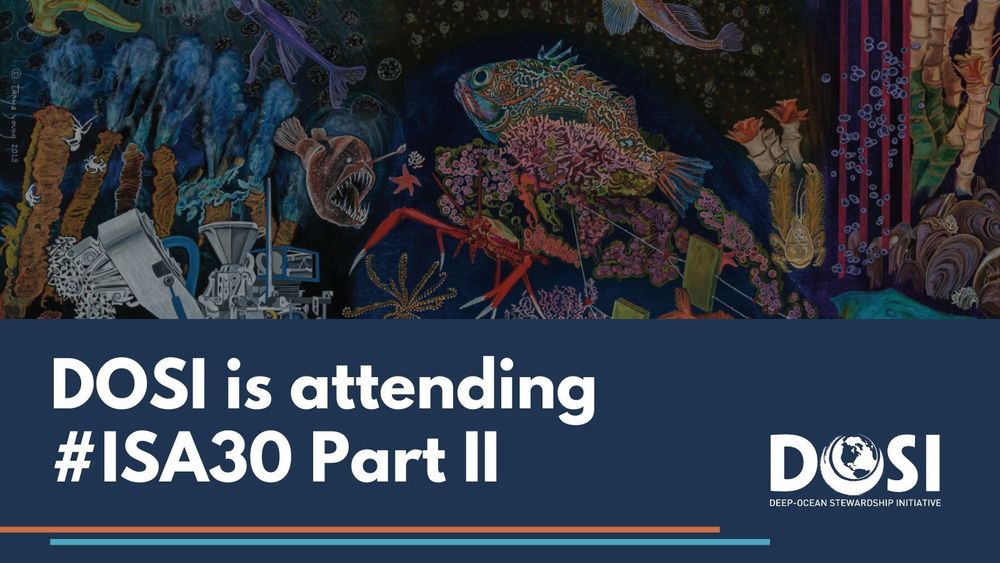
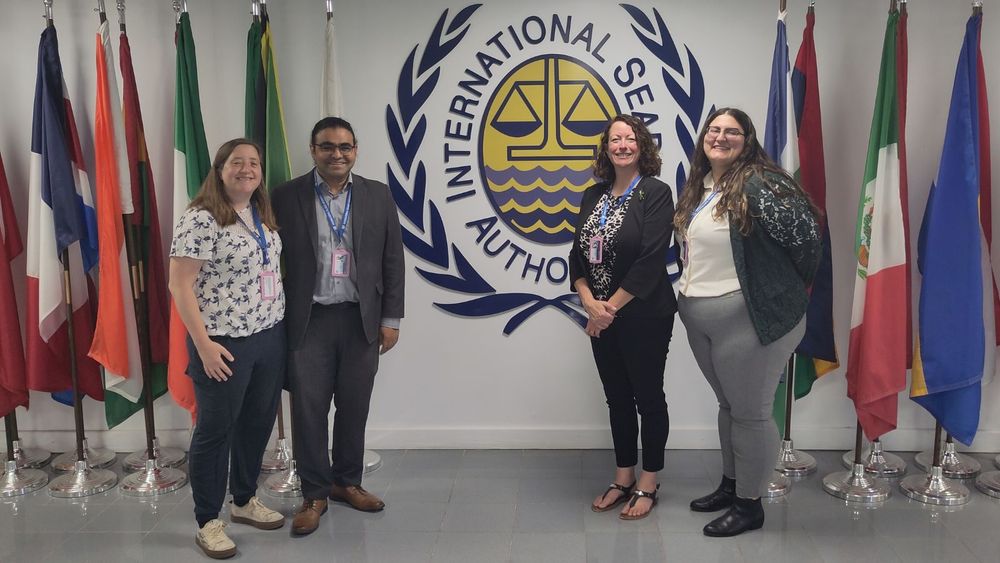
🌊 This week, DOSI is in Kingston, Jamaica for Part II of the 30th Session of the International Seabed Authority (ISA) #ISA30
The focus? Continuing negotiations on #DeepSeaMining regulations—a pivotal moment for the future of the #DeepOcean.
07.07.2025 19:10 — 👍 7 🔁 1 💬 1 📌 0
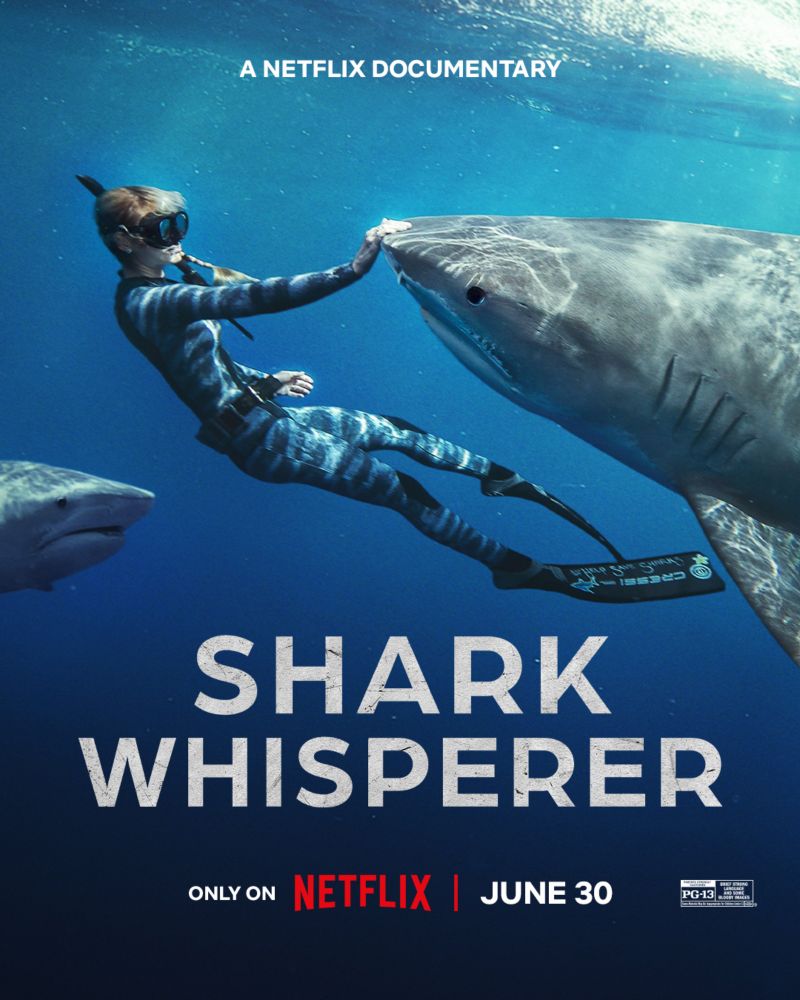
What Ocean Ramsey does is not shark science or conservation: some brief thoughts on “the Shark Whisperer” documentary
Netflix has a new (sarcastic air quotes) “documentary” out about Ocean Ramsey, who longtime readers and followers know is a serial wildlife harasser who also coordinates massive online …
Enough of you asked me about this that I wrote some brief thoughts on Ocean Ramsey's particular brand of pseudoscientific nonsense. I believe this addresses almost all of the frequently asked questions I receive, but as always I am happy to answer serious questions asked in good faith.
🧪🦑🌎🦈
02.07.2025 20:25 — 👍 689 🔁 258 💬 41 📌 32
PhD student at SFU in @earth2ocean.bsky.social , working with sharks, rays & MPAs 🦈✨🗺️, @uwsmea.bsky.social and @forestry.ubc.ca alum, divemaster & donut enthusiast (she/her)
Prof, mentor and leader of Governing Changing Oceans program, University of Melbourne ARC Laureate @jcuofficial.bsky.social @w-u-r.bsky.social @snappartnership.bsky.social
governingchange.org
Coordinating global efforts to research & conserve manta and devil rays, and their habitats.
Lecturer in marine top predator conservation @sosbangor.bsky.social
I research: sharks & rays | marine historical ecology | fisheries | conservation 🏊🤿🎣🐟
Research Scientist at the #Shark Research Foundation 🦈
Interested in the biophysical drivers of the movement and behaviour of #MarineMegafauna 🐋🐢🦭🐟
🧠🦗 base pairs, brains, behavior, biodiversity💡🦐
Herchel-Smith Fellow @ Cambridge in Zoology
🏳️🌈 he/him 🇵🇭 | no justice, no peace
Marine ecologist PhD, interested in #behaviour and #conservation of oceanic #predators. Postdoc JdC at @csic.es. Biodiversity explorer & @inaturalist.bsky.social curator. Co-funder of Ecoloxía Azul.
https://gonzalomucientes.wixsite.com/science
Deep-sea biologist. Natural History Museum, London, UK. www.nhm.ac.uk/deep-sea
We’re the museum looking deeper into the Earth’s past to shape a new future where both people and planet thrive.
Protecting the planet, it’s in our nature. 🌍
Boldly exploring our unknown Ocean
Biologist & Deep-Sea Explorer 🏴☠️ | Assistant professor at @plymbiomarsci.bsky.social | Macroecology | Hydrothermal vents 🌋 & Whale falls🐋 | Catalan
Assistant Professor of Biology at Boston University ::: Science Journalist / Communicator ::: National Geographic Explorer
Master’s student in Systematics and Evolution at the University of Alberta.
Interested in fishes and their diversity and evolution.
Professor of Marine Ecology at the University of Victoria, Impact Chair in Ocean Conservation
FFN+ PDRF at the University of Exeter.
Aquatic stressor biologist researching microplastics | microfibres | invasives | pollutants | fishes
Exeter Marine | Global Systems Institute | BU Visiting Fellow | FSBI council member | BRC Freshwater Fish Verifier
Follow us for coral reef related news, career postings, academic opportunities and more | We are a network of coral professionals and early career scientists
Working to ensure that wild populations are healthy and well-managed. Hosted by @projectseahorse
http://iucn-seahorse.org
















